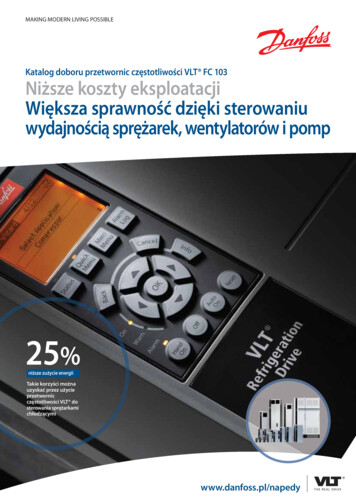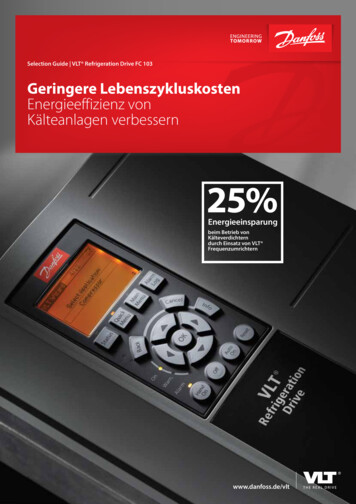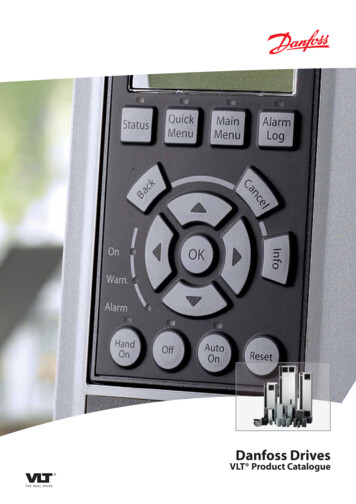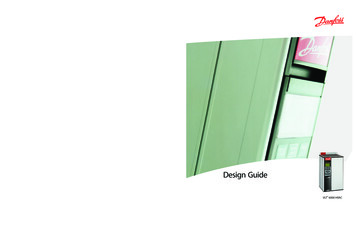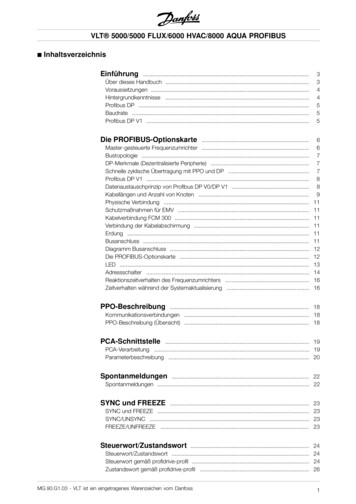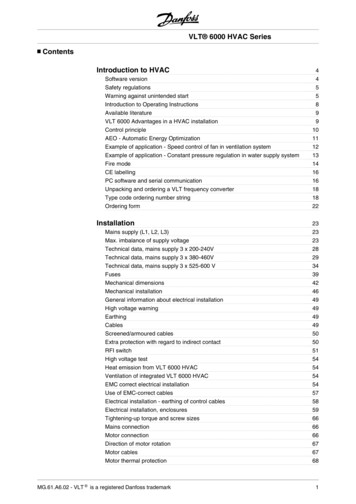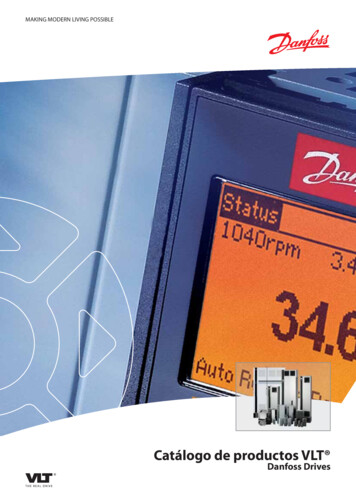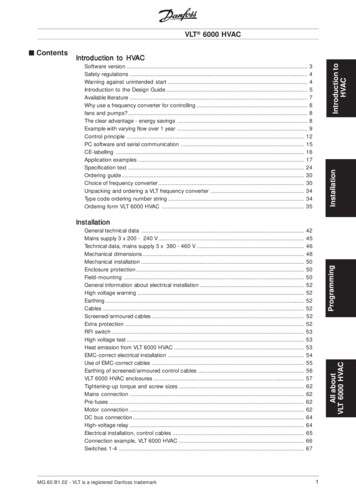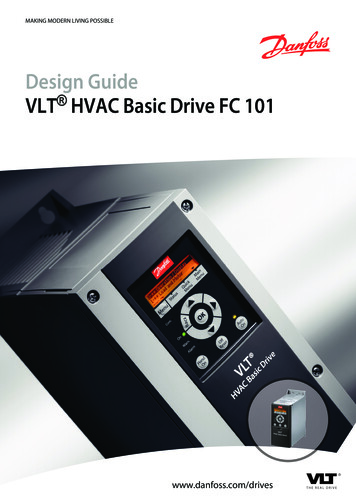
Transcription
MAKING MODERN LIVING POSSIBLEDesign GuideVLT HVAC Basic Drive FC 101www.danfoss.com/drives
ContentsDesign GuideContents1 Introduction51.1 Purpose of the Design Guide51.2 Document and Software Version51.3 Safety Symbols51.4 Abbreviations51.5 Additional Resources61.6 Definitions61.7 Power Factor81.8 Regulatory Compliance81.8.1 CE Mark81.8.2 UL Compliance91.8.3 C-tick Compliance92 Safety102.1 Qualified Personnel102.2 Safety Precautions103 Product Overview123.1 Advantages123.2 Control Structures253.2.1 Control Structure Open Loop253.2.2 PM/EC Motor Control253.2.3 Local (Hand On) and Remote (Auto On) Control263.2.4 Control Structure Closed Loop263.2.5 Feedback Conversion263.2.6 Reference Handling273.2.7 Tuning the Drive Closed Loop Controller283.2.8 Manual PI Adjustment283.3 Ambient Running Conditions283.4 General Aspects of EMC343.5 Galvanic Isolation (PELV)393.6 Earth Leakage Current403.7 Extreme Running Conditions404 Selection and OrderingMG18C602434.1 Type Code434.2 Options and Accessories444.2.1 Local Control Panel (LCP)444.2.2 Mounting of LCP in Panel Front444.2.3 IP21/NEMA Type 1 Enclosure Kit45Danfoss A/S 09/2014 All rights reserved.1
ContentsDesign Guide4.2.4 Decoupling Plate4.3 Ordering Numbers5 Installation47505.1 Mechanical Dimensions505.1.1 Side-by-Side Installation505.1.2 Frequency Converter Dimensions515.1.3 Shipping Dimensions535.2 Electrical Installation545.2.1 Electrical Wiring545.2.2 Electrical Installation in General555.2.3 Connecting to Mains and Motor565.2.4 Fuses and Circuit Breakers625.2.5 EMC-compliant Electrical Installation655.2.6 Control Terminals676 Programming686.1 Introduction686.2 Local Control Panel (LCP)686.3 Menus696.3.1 Status Menu696.3.2 Quick Menu696.3.3 Main Menu836.4 Quick Transfer of Parameter Settings between Multiple Frequency Converters836.5 Readout and Programming of Indexed Parameters836.6 Initialise the Frequency Converter to Default Settings in two Ways837 RS485 Installation and Set-up7.1 RS48524685857.1.1 Overview857.1.2 Network Connection857.1.3 Frequency Converter Hardware Set-up867.1.4 Parameter Settings for Modbus Communication867.1.5 EMC Precautions867.2 FC Protocol877.3 Parameter Settings to Enable the Protocol877.4 FC Protocol Message Framing Structure887.4.1 Content of a Character (Byte)887.4.2 Telegram Structure887.4.3 Telegram Length (LGE)887.4.4 Frequency Converter Address (ADR)88Danfoss A/S 09/2014 All rights reserved.MG18C602
ContentsDesign Guide7.4.5 Data Control Byte (BCC)887.4.6 The Data Field887.4.7 The PKE Field897.4.8 Parameter Number (PNU)897.4.9 Index (IND)897.4.10 Parameter Value (PWE)897.4.11 Data Types Supported by the Frequency Converter907.4.12 Conversion907.5 Examples907.6 Modbus RTU Overview917.6.1 Introduction917.6.2 Modbus RTU Overview917.6.3 Frequency Converter with Modbus RTU927.7 Network Configuration927.8 Modbus RTU Message Framing Structure927.8.1 Introduction927.8.2 Modbus RTU Message Structure927.8.3 Start/Stop Field927.8.4 Address Field937.8.5 Function Field937.8.6 Data Field937.8.7 CRC Check Field937.8.8 Coil Register Addressing937.8.9 How to Control the Frequency Converter957.8.10 Modbus Exception Codes967.9 How to Access Parameters967.9.1 Parameter Handling967.9.2 Storage of Data967.10 Examples977.10.1 Read Coil Status (01 hex)977.10.2 Force/Write Single Coil (05 hex)977.10.3 Force/Write Multiple Coils (0F hex)977.10.4 Read Holding Registers (03 hex)987.10.5 Preset Single Register (06 hex)987.10.6 Preset Multiple Registers (10 hex)997.11 Danfoss FC Control Profile7.11.1 Control Word According to FC Profile (8-10 Protocol FC profile)997.11.2 Status Word According to FC Profile (STW) (8-30 Protocol FC profile)1017.11.3 Bus Speed Reference Value1028 General SpecificationsMG18C60299103Danfoss A/S 09/2014 All rights reserved.3
ContentsDesign Guide8.1 Mains Supply Specifications1038.1.1 3x200–240 V AC1038.1.2 3x380–480 V AC1048.1.3 3x525–600 V AC1088.2 General Technical Data1098.2.1 Protection and Features1098.2.2 Mains Supply (L1, L2, L3)1098.2.3 Motor Output (U, V, W)1098.2.4 Cable Lengths and Cross-sections1098.2.5 Digital Inputs1108.2.6 Analog Inputs1108.2.7 Analog Output1108.2.8 Digital Output1108.2.9 Control Card, RS485 Serial Communication1118.2.10 Control Card, 24 V DC Output1118.2.11 Relay Output1118.2.12 Control Card, 10 V DC Output1118.2.13 Ambient Conditions1128.3 dU/Dt112Index4115Danfoss A/S 09/2014 All rights reserved.MG18C602
Design GuideIntroduction1 11 IntroductionNOTICE1.1 Purpose of the Design GuideThis design guide is intended for project and systemsengineers, design consultants, and application and productspecialists. Technical information is provided to understandthe capabilities of the frequency converter for integrationinto motor control and monitoring systems. Detailsconcerning operation, requirements, and recommendationsfor system integration are described. Information is provedfor input power characteristics, output for motor control,and ambient operating conditions for the converter.Also included are safety features, fault conditionmonitoring, operational status reporting, serial communication capabilities, and programmable options andfeatures. Design details such as site requirements, cables,fuses, control wiring, unit sizes and weights, and othercritical information necessary to plan for system integrationis also provided.Reviewing the detailed product information in the designstage enables developing a well-conceived system withoptimal functionality and efficiency.Indicates important information, including situations thatcan result in damage to equipment or property.1.4 AbbreviationsAlternating currentACAmerican wire gaugeAWGAmpere/AMPAAutomatic motor adaptationAMACurrent limitILIMDegrees celsius CDirect currentDCElectro magnetic compatibilityEMCElectronic thermal relayETRFrequency converterFCGramgHertzHzKilohertzkHzLocal control panelLCPMetermMillihenry inductancemHMilliamperemAMillisecondms1.2 Document and Software VersionMinuteminMotion control toolMCTThis manual is regularly reviewed and updated. Allsuggestions for improvement are welcome.NanofaradnFNewton metersNmNominal motor currentIM,NNominal motor frequencyfM,NNominal motor powerPM,NVLT is a registered trademarkEditionRemarksSoftware versionMG18C6xxReplaces MG18C5xx2.70Table 1.1 Document and Software Version1.3 Safety SymbolsThe following symbols are used in this document:WARNINGIndicates a potentially hazardous situation that couldresult in death or serious injury.CAUTIONIndicates a potentially hazardous situation that couldresult in minor or moderate injury. It can also be used toalert against unsafe practices.MG18C602Nominal motor voltageUM,NProtective extra low voltagePELVPrinted circuit boardPCBRated inverter output currentIINVRevolutions per minuteRPMRegenerative terminalsRegenSecondsSynchronous motor speednsTorque limitTLIMVoltsVThe maximum output currentIVLT,MAXThe rated output current supplied by thefrequency converterIVLT,NTable 1.2 AbbreviationsDanfoss A/S 09/2014 All rights reserved.5
1 1IntroductionDesign Guide1.5 Additional ResourcesInput VLT HVAC Basic Drive FC 101 Quick Guideprovides basic information on mechanicaldimensions, installation and programming VLT HVAC Basic Drive FC 101 Programming Guideprovides information on how to programme, andincludes complete parameter descriptions. .Danfoss VLT Energy Box software. Select PCSoftware Download at www.danfoss.com/BusinessAreas/DrivesSolutions.VLT Energy Box software allows energyconsumption comparisons of HVAC fans andpumps driven by Danfoss frequency convertersand alternative methods of flow control. Use thistool to accurately project the costs, savings, andpayback of using Danfoss frequency converterson HVAC fans, pumps, and cooling towers.Danfoss technical literature is available in electronic formon the documentation CD that is shipped with theproduct, or in print from your local Danfoss sales office.MCT 10 Set-up Software SupportDownload the software from ns/Software MCT10/MCT10 Downloads.htm.During the installation process of the software, enteraccess code 81463800 to activate FC 101 functionality. Alicence key is not required for using FC 101 functionality.The latest software do not always contain the latest driveupdates. Contact the local sales office for the latest driveupdates (*.upd files), or download the drive updates fc101driveupdates.1.6 DefinitionsThe connected motor canstart and stop with LCP andthe digital inputs.Functions are divided into 2groups.Functions in group 1 havehigher priority thanfunctions in group 2.Group1Group2Reset, coasting stop, resetand coasting stop, quickstop, DC braking, stopand the [Off] key.Start, pulse start,reversing, start reversing,jog and freeze outputTable 1.3 Control CommandsMotorfJOGThe motor frequency when the jog function is activated(via digital terminals).fMThe motor frequency.fMAXThe maximum motor frequency.fMINThe minimum motor frequency.fM,NThe rated motor frequency (nameplate data).IMThe motor current.IM,NThe rated motor current (nameplate data).nM,NThe rated motor speed (nameplate data).PM,NThe rated motor power (nameplate data).UMThe instantaneous motor voltage.UM,NThe rated motor voltage (nameplate data).Frequency ConverterIVLT,MAXThe maximum output current.IVLT,NThe rated output current supplied by the frequencyconverter.UVLT, MAXThe maximum output voltage.6Danfoss A/S 09/2014 All rights reserved.MG18C602
Design GuideIntroductionBreak-away torque1 1There are 2 types of analog inputs:175ZA078.10TorquePull-out Current input: 0-20 mA and 4-20 mAVoltage input: 0-10 V DCAnalog outputsThe analog outputs can supply a signal of 0-20 mA, 4-20mA, or a digital signal.Automatic Motor Adaptation, AMAAMA algorithm determines the electrical parameters forthe connected motor at standstill.Digital inputsThe digital inputs can be used for controlling variousfunctions of the frequency converter.rpmIllustration 1.1 Break-away TorqueηVLTThe efficiency of the frequency converter is defined as theratio between the power output and the power input.Start-disable commandA stop command belonging to the group 1 controlcommands, see Table 1.3.Stop commandSee Table 1.3.ReferencesAnalog referenceA signal transmitted to the analog inputs 53 or 54. It canbe voltage or current. Current input: 0-20 mA and 4-20 mAVoltage input: 0-10 V DCBus referenceA signal transmitted to the serial communication port (FCport).Preset referenceA defined preset reference to be set from -100% to 100%of the reference range. Selection of 8 preset references viathe digital terminals.RefMAXDetermines the relationship between the reference inputat 100% full scale value (typically 10 V, 20 mA) and theresulting reference. The maximum reference value set in3-03 Maximum Reference.Digital outputsThe frequency converter features 2 solid state outputs thatcan supply a 24 V DC (max. 40 mA) signal.Relay outputsThe frequency converter features 2 programmable relayoutputs.ETRElectronic thermal relay is a thermal load calculation basedon present load and time. Its purpose is to estimate themotor temperature, and prevent overtemperature of themotor.InitialisingIf initialising is carried out (14-22 Operation Mode), theprogrammable parameters of the frequency converterreturn to their default settings.14-22 Operation Mode does not initialise communicationparameters, fault log, or fire mode log.Intermittent duty cycleAn intermittent duty rating refers to a sequence of dutycycles. Each cycle consists of an on-load and an off-loadperiod. The operation can be either periodic duty or noneperiodic duty.LCPThe local control panel (LCP) makes up a completeinterface for control and programming of the frequencyconverter. The control panel is detachable on IP20 unitsand fixed on IP54 units. It can be installed up to 3 m fromthe frequency converter, i.e. in a front panel with theinstallation kit option.lsbLeast significant bit.MCMShort for mille circular mil, an American measuring unit forcable cross-section. 1 MCM 0.5067 mm2.RefMINDetermines the relationship between the reference inputat 0% value (typically 0 V, 0 mA, 4 mA) and the resultingreference. The minimum reference value set in3-02 Minimum ReferencemsbMost significant bit.MiscellaneousAnalog inputsThe analog inputs are used for controlling variousfunctions of the frequency converter.On-line/Off-line parametersChanges to on-line parameters are activated immediatelyafter the data value is changed. Press [OK] to activate offline parameters.MG18C602Danfoss A/S 09/2014 All rights reserved.7
1 1IntroductionDesign GuidePI controllerThe PI controller maintains the desired speed, pressure,temperature, etc. by adjusting the output frequency tomatch the varying load.RCDResidual current device.Set-upParameter settings in 2 set-ups can be saved. Changebetween the 2 parameter set-ups and edit 1 set-up, whileanother set-up is active.Slip compensationThe frequency converter compensates for the motor slipby giving the frequency a supplement that follows themeasured motor load keeping the motor speed almostconstant.Smart Logic Control (SLC)The SLC is a sequence of user-defined actions executedwhen the associated user-defined events are evaluated astrue by the SLC.ThermistorA temperature-dependent resistor placed where thetemperature is to be monitored (frequency converter ormotor).TripA state entered in fault situations, e.g. if the frequencyconverter is subject to an overtemperature or when thefrequency converter is protecting the motor, process ormechanism. Restart is prevented until the cause of thefault has disappeared and the trip state is cancelled byactivating reset or, in some cases, by being programmedto reset automatically. Trip may not be used for personalsafety.Trip lockedA state entered in fault situations when the frequencyconverter is protecting itself and requiring physicalintervention, for example, if the frequency converter issubject to a short circuit on the output. A locked trip canonly be cancelled by cutting off mains, removing the causeof the fault, and reconnecting the frequency converter.Restart is prevented until the trip state is cancelled byactivating reset or, in some cases, by being programmedto reset automatically. Trip locked may not be used forpersonal safety.VT characteristicsVariable torque characteristics used for pumps and fans.VVC If compared with standard voltage/frequency ratio control,voltage vector control (VVC ) improves the dynamics andthe stability, both when the speed reference is changedand in relation to the load torque.81.7 Power FactorThe power factor indicates to which extent the frequencyconverter imposes a load on the mains supply. The powerfactor is the ratio between I1 and IRMS, where I1 is thefundamental current, and IRMS is the total RMS currentincluding harmonic currents. The lower the power factor,the higher the IRMS for the same kW performance.Power factor 3 U I 1 COS ϕ3 U IRMSThe power factor for 3-phase control:Power factor I1 cosϕ1I1 since cos ϕ1 1IRMSIRMSIRMS I21I25 I27 . . I2nA high power factor indicates that the different harmoniccurrents are low.The frequency converters built-in DC coils produce a highpower factor, which minimises the imposed load on themains supply.1.8 Regulatory ComplianceFrequency converters are designed in compliance with thedirectives described in this section.1.8.1 CE MarkThe CE mark (Communauté Européenne) indicates that theproduct manufacturer conforms to all applicable EUdirectives. The EU directives applicable to the design andmanufacture of frequency converters are listed in Table 1.4.NOTICEThe CE mark does not regulate the quality of theproduct. Technical specifications cannot be deducedfrom the CE mark.NOTICEFrequency converters with an integrated safety functionmust comply with the machinery directive.EU directiveVersionLow voltage directive2006/95/EC; IEC 61800-5-1 (2003)EMC directive2004/108/ECErP directiveTable 1.4 EU Directives Applicable to Frequency ConvertersDeclarations of conformity are available on request.Danfoss A/S 09/2014 All rights reserved.MG18C602
IntroductionDesign Guide1 11.8.3 C-tick Compliance1.8.1.1 Low Voltage DirectiveThe low voltage directive applies to all electricalequipment in the 50–1000 V AC and the 75–1600 V DCvoltage ranges.The aim of the directive is to ensure personal safety andavoid property damage, when operating electricalequipment that is installed and maintained correctly, in itsintended application.Illustration 1.3 C-tick1.8.1.2 EMC DirectiveThe purpose of the EMC (electromagnetic compatibility)directive is to reduce electromagnetic interference andenhance immunity of electrical equipment and installations. The basic protection requirement of the EMCDirective 2004/108/EC states that devices that generateelectromagnetic interference (EMI), or whose operationcould be affected by EMI, must be designed to limit thegeneration of electromagnetic interference and shall havea suitable degree of immunity to EMI when properlyinstalled, maintained, and used as intended.Electrical equipment devices used alone or as part of asystem must bear the CE mark. Systems do not require theCE mark, but must comply with the basic protectionrequirements of the EMC directive.1.8.1.3 ErP DirectiveThe ErP directive is the European Ecodesign Directive forenergy-related products. The directive sets ecodesignrequirements for energy-related products, includingfrequency converters. The aim of the directive is toincrease energy efficiency and the level of protection ofthe environment, while at the same time increasing thesecurity of the energy supply. Environmental impact ofenergy-related products includes energy consumptionthroughout the entire product life cycle.1.8.2 UL ComplianceUL ListedIllustration 1.2 ULNOTICEIP54 units are not certified for UL.The frequency converter complies with UL508C thermalmemory retention requirements. For more information,refer to the section Motor Thermal Protection in theproduct specific design guide.MG18C602Danfoss A/S 09/2014 All rights reserved.9
2 2Design GuideSafety2 SafetyWARNING2.1 Qualified PersonnelCorrect and reliable transport, storage, installation,operation, and maintenance are required for the troublefree and safe operation of the frequency converter. Onlyqualified personnel are allowed to install or operate thisequipment.Qualified personnel are defined as trained staff, who areauthorised to install, commission, and maintain equipment,systems, and circuits in accordance with pertinent laws andregulations. Additionally, the personnel must be familiarwith the instructions and safety measures described in thismanual.2.2 Safety PrecautionsDISCHARGE TIME!Frequency converters contain DC-link capacitors that canremain charged even when the frequency converter isnot powered. To avoid electrical hazards, disconnect ACmains, any permanent magnet type motors, and anyremote DC-link power supplies, including batterybackups, UPS and DC-link connections to otherfrequency converters. Wait for the capacitors to fullydischarge before performing any service or repair work.The amount of waiting time is listed in Table 2.1. Failureto wait the specified time after power has been removedbefore doing service or repair could result in death orserious injury.Voltage [V]Power range [kW(HP)]HIGH VOLTAGE3x2000.25–3.7 (0.33-5)4Frequency converters contain high voltage whenconnected to AC mains input, DC power supply, or loadsharing. Failure to perform installation, start-up, andmaintenance by qualified personnel can result in deathor serious injury.3x2005.5–11 (7-15)153x4000.37–7.5 (0.5–10)43x40011–90 (15–125)15WARNING Installation, start-up, and maintenance must beperformed by qualified personnel only.3x6002.2–7.5 (3–10)43x60011–90 (15–125)15Table 2.1 Discharge TimeWARNINGWARNINGLEAKAGE CURRENT HAZARDUNINTENDED STARTWhen the frequency converter is connected to AC mains,DC power supply, or load sharing, the motor may start atany time. Unintended start during programming, service,or repair work can result in death, serious injury, orproperty damage. The motor can start by means of anexternal switch, a serial bus command, an inputreference signal from the LCP or LOP, via remoteoperation using MCT 10 software, or after a cleared faultcondition.To prevent unintended motor start:10Minimum waiting time(minutes) Disconnect the frequency converter from themains. Press [Off/Reset] on the LCP beforeprogramming parameters. Ensure that the frequency converter is fullywired and assembled when it is connected toAC mains, DC power supply, or load sharing.Leakage currents exceed 3.5 mA. Failure to ground thefrequency converter properly can result in death orserious injury. Ensure the correct grounding of the equipmentby a certified electrical installer.WARNINGEQUIPMENT HAZARDContact with rotating shafts and electrical equipmentcan result in death or serious injury. Ensure that only trained and qualifiedpersonnel perform installation, start up, andmaintenance. Ensure that electrical work conforms to nationaland local electrical codes. Follow the procedures in this manual.Danfoss A/S 09/2014 All rights reserved.MG18C602
SafetyDesign GuideCAUTIONINTERNAL FAILURE HAZARD2 2An internal failure in the frequency converter can resultin serious injury, when the frequency converter is notproperly closed. Ensure that all safety covers are in place andsecurely fastened before applying power.MG18C602Danfoss A/S 09/2014 All rights reserved.11
3.1 Advantages120A3.1.1 Why use a Frequency Converter forControlling Fans and Pumps?100SYSTEM CURVEPRESSURE %80A frequency converter takes advantage of the fact thatcentrifugal fans and pumps follow the laws of proportionality for such fans and pumps. For further informationsee chapter 3.1.3 Example of Energy Savings.120A100SYSTEM CURVE80B60406020406080 100Voume %1201401601806080100Voume %120140160180120100806040200C20CENERGYCONSUMEDFAN CURVE2040Illustration 3.2 Energy Savings with Frequency ConverterSolution200400INPUT POWER %130BA780.11The clear advantage of using a frequency converter forcontrolling the speed of fans or pumps lies in theelectricity savings.When comparing with alternative control systems andtechnologies, a frequency converter is the optimum energycontrol system for controlling fan and pump systems.FAN CURVEB60203.1.2 The Clear Advantage - Energy Savings40130BA781.113 Product OverviewPRESSURE%3 3Design GuideProduct Overview80 100 120VOLUME%140160180Illustration 3.1 Fan Curves (A, B, and C) for Reduced FanVolumesWhen using a frequency converter to reduce fan capacityto 60% - more than 50% energy savings may be obtainedin typical applications.3.1.3 Example of Energy SavingsAs shown in Illustration 3.3, the flow is controlled bychanging the RPM. By reducing the speed only 20% fromthe rated speed, the flow is also reduced by 20%. This isbecause the flow is directly proportional to the RPM. Theconsumption of electricity, however, is reduced by 50%.If the system in question only needs to be able to supply aflow that corresponds to 100% a few days in a year, whilethe average is below 80% of the rated flow for theremainder of the year, the amount of energy saved is evenmore than 50%.Illustration 3.3 describes the dependence of flow, pressureand power consumption on RPM.12Danfoss A/S 09/2014 All rights reserved.MG18C602
Design Guide100%130BA782.10175HA208.10Product Overview80%3 3Dischargedamper50%Flow nLess energy savingsPressure n225%Power n312,5%n50%80% 100%Illustration 3.3 Laws of ProportionallyMaximum energy savingsIGVQ1n1Flow : Q2n2H1n1 2Pressure : H2n2P1n1 3Power : P2n2P2 Reduced powerH Pressuren Speed regulationH1 Rated pressuren1 Rated speedH2 Reduced pressuren2 Reduced speed10080Input power %Table 3.1 The Laws of Proportionality3.1.4 Comparison of Energy SavingsThe Danfoss frequency converter solution offers majorsavings compared with traditional energy saving solutionssuch as discharge damper solution and inlet guide vanes(IGV) solution. This is because the frequency converter isable to control fan speed according to thermal load on thesystem, and the frequency converter has a built-in facilitythat enables the frequency converter to function as abuilding management system, BMS.Illustration 3.3 shows typical energy savings obtainablewith 3 well-known solutions when fan volume is reducedto i.e. 60%.As the graph shows, more than 50% energy savings can beachieved in typical applications.MG18C602Discharge Damper SolutionIGV Solution60402000600VLT SolutionEnergy consumedP1 Rated powerQ2 Reduced flowEnergy consumedQ1 Rated flow130BA779.12P PowerEnergy consumedQ FlowCostlier installationIllustration 3.4 The 3 Common Energy Saving Systems60060Volume %Illustration 3.5 Energy SavingsDischarge dampers reduce power consumption. Inlet guidevanes offer a 40% reduction, but are expensive to install.The Danfoss frequency converter solution reduces energyconsumption with more than 50% and is easy to install. Italso reduces noise, mechanical stress and wear-and-tear,and extends the life span of the entire application.Danfoss A/S 09/2014 All rights reserved.13
Hs(mwg)175HA209.113.1.5 Example with Varying Flow over 1Year60This example is calculated based on pump characteristicsobtained from a pump datasheet.The result obtained shows energy savings in excess of 50%at the given flow distribution over a year. The paybackperiod depends on the price per kWh and price offrequency converter. In this example it is less than a yearwhen compared with valves and constant speed.50B4030A20C1050rpm750rpmEnergy savingsPshaft Pshaft output[h]1650rpm1350rpm100175HA210.113 3Design GuideProduct Overviewt2000100200300400(m3 300Q[m3 /h]1350rpmB12010C1Illustration 3.6 Flow Distribution over 1 Year01050rpm750rpm100200400 (m3 /h)300Illustration 3.7 lve regulationConsumptionPowerA1 - B1kWhA1 - �100 8760PowerFrequency convertercontrol275.064Consumption6.13226.801Table 3.2 Result14Danfoss A/S 09/2014 All rights reserved.MG18C602
Product OverviewDesign Guide3.1.8 Using a Frequency Converter SavesMoney3.1.6 Better ControlIf a frequency converter is used for controlling the flow orpressure of a system, improved control is obtained.A frequency converter can vary the speed of the fan orpump, obtaining variable control of flow and pressure.Furthermore, a frequency converter can quickly adapt thespeed of the fan or pump to new flow or pressureconditions in the system.Simple control of process (flow, level or pressure) utilisingthe built-in PI control.3.1.7 Star/Delta Starter or Soft Starter notRequiredThe example in chapter 3.1.9 Without a Frequency Convertershows that a lot of equipment is not required when afrequency converter is used. It is possible to calculate thecost of installing the 2 different systems. In the example,the 2 systems can be established at roughly the sameprice.Use the VLT Energy Box software that is introduced inchapter 1.5 Additional Resources to calculate the costsavings that can be achieved by using a frequencyconverter.When larger motors are started, it is necessary in manycountries to use equipment that limits the start-up current.In more traditional systems, a star/delta starter or softstarter is widely used. Such motor starters are not requiredif a frequency converter is used.As illustrated in Illustration 3.8, a frequency converter doesnot consume more than rated current.175HA227.10800700600% Full load current45004003003200210001012,52537,550HzFull load& speed1 VLT HVAC Basic Drive FC 1012 Star/delta starter3 Soft starter4 Start directly on mainsIllustration 3.8 Start-up CurrentMG18C602Danfoss A/S 09/2014 All rights reserved.153 3
Product OverviewDesign Guide3.1.9 Without a Frequency Converter3 3Heating ypassFan sectionSupplyairFanM Flow3-PortvalveReturnInlet guide vaneBypassV.A.VSensorsPT175HA205.12Cooling sectionoutletsControlMechanicallinkageand nsMainsDirect digital controlE.M.S.Energy management systemVariable air volumeSensor PPressureSensor 0/10VIllustration 3.9 Traditional Fan System16Danfoss A/S 09/2014 All rights reserved.MG18C602
Product OverviewDesign GuideCooling sectionHeating section-SupplyairFanM FlowReturnFan sectionSensorsPTV.A.V175HA206.113.1.10 With a Frequency ntroltemperature0-10Vor0/4-20mAD.D.C.Direct digital controlE.M.S.Energy management systemV.A.V.Variable air volumeSensor PPressureSensor .C.controlMainB.M.SMainsIllustration 3.10 Fan System Controlled by Frequency ConvertersMG18C602Danfoss A/S 09/2014 All rights reserved.173 3
Design Guide3.1.11 Application Examples3.1.13 The VLT SolutionThe following sections give typical examples ofapplications within HVAC.While dampers and IGVs work to maintain a constantpressure in the ductwork, a frequency converter solutionsaves much more energy and reduces the complexity ofthe installation. Instead of creating an artificial pressuredrop or causing a decrease in fan efficiency, the frequencyconverter decreases the speed of the fan to provide theflow and pressure required by the system.Centrifugal devices such as fans behave according to thecentrifugal laws. This means that the fans decrease thepressure and flow they produce as their sp
consumption comparisons of HVAC fans and pumps driven by Danfoss frequency converters and alternative methods of flow control. Use this tool to accurately project the costs, savings, and payback of using Danfoss frequency converters on HVAC fans, pumps, and cooling towers. Danfoss technical literature is available in electronic form

